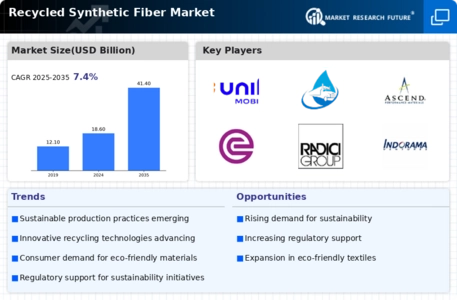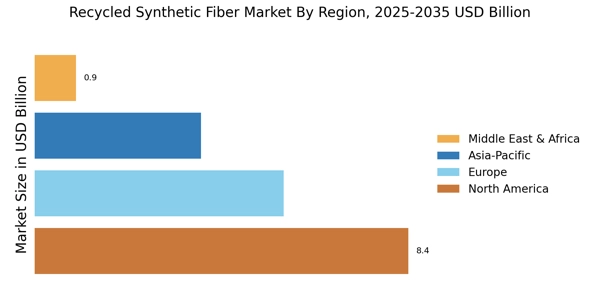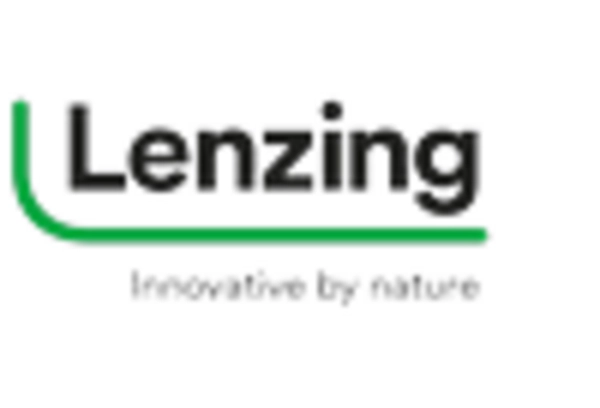Collaboration Across Industries
Collaboration across various industries is emerging as a key driver for the Recycled Synthetic Fiber Market. Partnerships between textile manufacturers, recycling companies, and technology providers are fostering innovation and enhancing the supply chain for recycled fibers. These collaborations enable the sharing of resources and expertise, leading to improved recycling processes and product development. For instance, initiatives that bring together fashion brands and recycling firms are creating closed-loop systems that facilitate the collection and recycling of synthetic materials. This collaborative approach not only boosts the availability of recycled synthetic fibers but also strengthens the overall market ecosystem. As more stakeholders engage in these partnerships, the Recycled Synthetic Fiber Market is poised for substantial growth.
Rising Awareness of Environmental Impact
There is a growing awareness of the environmental impact associated with synthetic fibers, which is driving the Recycled Synthetic Fiber Market. Consumers are becoming more informed about the detrimental effects of plastic pollution and are actively seeking alternatives. This shift in consumer consciousness is prompting brands to incorporate recycled materials into their products. Market Research Future indicates that approximately 60% of consumers are willing to pay a premium for products made from recycled materials. This trend is encouraging manufacturers to invest in the development of recycled synthetic fibers, thereby contributing to the overall growth of the Recycled Synthetic Fiber Market. As awareness continues to rise, the demand for sustainable options is likely to increase.
Regulatory Frameworks Promoting Recycling
The Recycled Synthetic Fiber Market is significantly influenced by regulatory frameworks that promote recycling and sustainable practices. Governments are implementing policies aimed at reducing plastic waste and encouraging the use of recycled materials. For instance, several countries have introduced regulations mandating the use of a certain percentage of recycled content in textiles. These regulations not only support the growth of the Recycled Synthetic Fiber Market but also create a competitive advantage for companies that prioritize sustainability. As these policies become more widespread, the market is expected to expand, with an increasing number of manufacturers adopting recycled synthetic fibers to comply with regulations and meet consumer demand.
Increasing Demand for Sustainable Products
The Recycled Synthetic Fiber Market is experiencing a notable surge in demand for sustainable products. Consumers are increasingly prioritizing eco-friendly options, leading to a shift in purchasing behavior. This trend is reflected in the textile and apparel sectors, where brands are adopting recycled materials to meet consumer expectations. According to recent data, the market for recycled fibers is projected to grow at a compound annual growth rate of approximately 8% over the next five years. This growth is driven by heightened awareness of environmental issues and the desire for sustainable fashion. As a result, companies within the Recycled Synthetic Fiber Market are investing in innovative recycling technologies to enhance product offerings and reduce environmental impact.
Technological Innovations in Recycling Processes
Technological advancements play a crucial role in the Recycled Synthetic Fiber Market. Innovations in recycling processes, such as chemical recycling and advanced sorting technologies, are enhancing the efficiency and quality of recycled fibers. These technologies enable the conversion of post-consumer plastics into high-quality fibers, which can be used in various applications, including clothing and home textiles. The introduction of these technologies is expected to increase the availability of recycled synthetic fibers, thereby meeting the growing demand from manufacturers. Furthermore, the Recycled Synthetic Fiber Market is likely to benefit from ongoing research and development efforts aimed at improving recycling methods, which could lead to a more circular economy in the textile sector.


















Leave a Comment